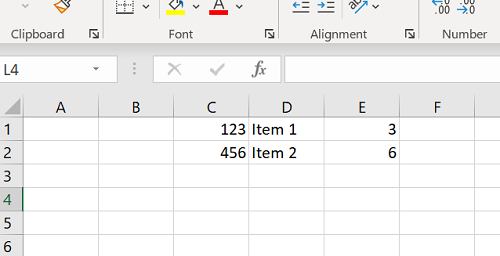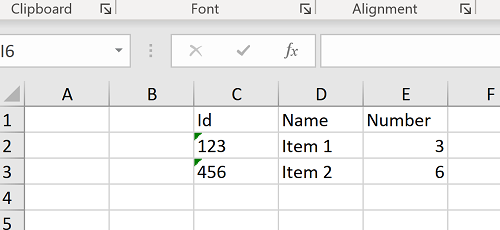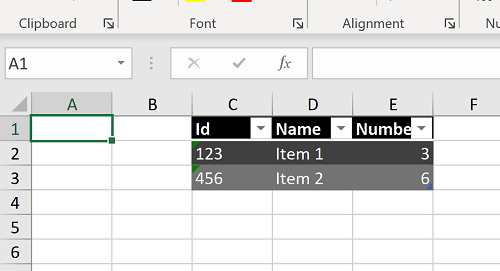-
Notifications
You must be signed in to change notification settings - Fork 294
LoadFromCollection
This method provides an easy way to load data from IEnumerables of .NET classes into a spreadsheet. From EPPlus 5.5 you can use attributes to get more fine granular control over the spreadsheet table and add calculated columns.
We can start with the following simple class...
public class MyClass
{
public string Id { get; set; }
public string Name { get; set; }
public int Number { get; set; }
}...and a a few instances of it in a List.
var items = new List<MyClass>()
{
new MyClass(){ Id = "123", Name = "Item 1", Number = 3},
new MyClass(){ Id = "456", Name = "Item 2", Number = 6}
};Now let's create a workbook with a worksheet and add this data into it using the LoadFromCollection method. The method returns the range to which data was imported.
using (var pck = new ExcelPackage())
{
var sheet = pck.Workbook.Worksheets.Add("sheet");
var range = sheet.Cells["C1"].LoadFromCollection(items);
}This will load the following data into the worksheet.

LoadFromCollection has several method signatures and argument number 2 specifies if we should have a row with headers above the data. In this case the headers will have the same values as the names of the class properties, i.e. "Id", "Name" and "Number".
sheet.Cells["C1"].LoadFromCollection(items, true);...alternatively (from version 5.2.1 and higher):
sheet.Cells["C1"].LoadFromCollection(items, c => c.PrintHeaders = true);This will load the following data into the worksheet.

The third argument - TableStyle - gives you the possibility to style the range as a table.
var tableRange = sheet.Cells["C1"].LoadFromCollection(items, true, TableStyles.Dark1);
// to get access to the created table:
var table = sheet.Tables.GetFromRange(tableRange);...alternatively (from version 5.2.1 and higher):
var tableRange = sheet.Cells["C1"].LoadFromCollection(items, c => {
c.PrintHeaders = true;
c.TableStyle = TableStyles.Dark1;
});
// to get access to the created table:
var table = sheet.Tables.GetFromRange(tableRange);...and this gives us the following result:

The TableStyles enum gives you over 60 different table styles to pick from!
The default behaviour of the LoadFromCollection method is to replace underscores with a space - "My_property" will be "My property". But there are a few options to configure this.
If you decorate the members of your class with the System.ComponentModel.DescriptionAttribute the value of this attribute will be used instead of the name of the property. If this attribute is not present EPPlus will look for the System.ComponentModel.DisplayNameAttribute. If none of this is present it will use the default behaviour (see above).
public class MyClass
{
[DisplayName("The id")]
public string Id { get; set; }
[Description("The name")]
public string Name { get; set; }
public int Number { get; set; }
}Available from version 5.2.1 and higher
The HeaderParsingType argument is available on the following method signature:
sheet.Cells["C1"].LoadFromCollection(items, c => {
c.PrintHeaders = true;
c.HeaderParsingType = HeaderParsingTypes.CamelCaseToSpace;;
});If you set HeaderParsingType to HeaderParsingTypes.Preserve the header will be exactly like the member name. If you set it to HeaderParsingTypes.CamelCaseToSpace it will put a space before each capital letter in the property name ("MyProperty" to "My Property").
You can transpose the data from you load from any collection by passing true as the Transpose parameter.
sheet.Cells["C1"].LoadFromCollection(items, true, TableStyles.Dark1, true);Alternatively
sheet.Cells["C1"].LoadFromCollection(items, c =>
{
c.Transpose = true;
});The default behaviour is to import all members of a class, but you can specify which members to import with the Members argument. See the following example:
var t = typeof(MyClass);
sheet.Cells["C1"].LoadFromCollection(items, true, TableStyles.Dark1, LoadFromCollectionParams.DefaultBindingFlags,
new MemberInfo[]
{
t.GetProperty("Id"),
t.GetProperty("Name")
});...alternatively:
var t = typeof(MyClass);
sheet.Cells["C1"].LoadFromCollection(items, c => {
c.PrintHeaders = true;
c.Members = new MemberInfo[]
{
t.GetProperty("Id"),
t.GetProperty("Name")
}
});From EPPlus version 5.6.1 a class exposing an property of type System.Uri or OfficeOpenXml.ExcelHyperLink will set the hyperlink property for cells in that column.
This example shows how to add a 'Mail To' property, setting the displayed text to the Name:
public ExcelHyperLink MailTo
{
get
{
var url = new ExcelHyperLink("mailto:" + EMailAddress);
url.Display = Name;
return url;
}
}The ExcelHyperLink class can also be used to create links to cells inside the workbook.
To add a column with url's, just create a property of type Uri in your class:
public Uri Url
{
get;
set;
}EPPlus Software AB - https://epplussoftware.com
- What is new in EPPlus 5+
- Breaking Changes in EPPlus 5
- Breaking Changes in EPPlus 6
- Breaking Changes in EPPlus 7
- Breaking Changes in EPPlus 8
- Addressing a worksheet
- Dimension/Used range
- Copying ranges/sheets
- Insert/Delete
- Filling ranges
- Sorting ranges
- Taking and skipping columns/rows
- Data validation
- Comments
- Freeze and Split Panes
- Header and Footer
- Hyperlinks
- Autofit columns
- Grouping and Ungrouping Rows and Columns
- Formatting and styling
- The ExcelRange.Text property
- Conditional formatting
- Using Themes
- Working with custom named table- or slicer- styles